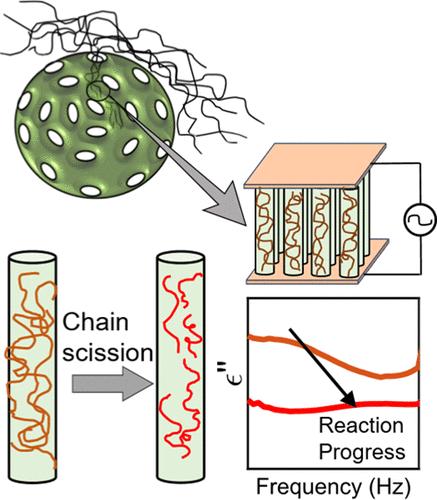Monitoring Depolymerization in Mesopores Using Dynamic Properties of Polymeric Melt Accessed via Dielectric Spectroscopy
IF 5.2
1区 化学
Q1 POLYMER SCIENCE
引用次数: 0
Abstract
Traditional design principles for heterogeneous catalysis guide the use of catalytic particles with mesosized (∼2–50 nm) pores to increase the number of surface-active sites by way of an increased surface area. However, the entry of long-chain polymers into such pores may be significantly limited by the size and entanglement of polymers in the melt state, thereby decreasing the number of accessible sites. Assessment of catalyst performance from traditional reactor-based studies averages over intrapore reaction events as well as reactions on the surface of a particle, resulting in an inability to distinguish between differences in site accessibility and activity. Techniques that assess the intrapore performance can inform the design of future heterogeneous catalysts for polymer upcycling. In this work, we demonstrate the use of broadband dielectric spectroscopy to monitor depolymerization of a polymer melt within mesopores via changes in the segmental relaxation time scale of amorphous polymer chains. In particular, we highlight the use of an anodic aluminum oxide (AAO) membrane as a readily available model for catalyst pores with a well-characterized pore morphology. The decrease in the segmental relaxation (α-relaxation) time of the melt with increasing chain scission emerges as a measure of the extent of polymer deconstruction inside mesopores. To demonstrate the utility of this technique, we demonstrate the decomposition of two commercial poly(propylene carbonate) polymers with different decomposition rates within mesopores. As the polymers depolymerize, their segmental relaxation time decreases as the molecular weight decreases (as predicted by the Fox–Flory equation). The BDS-measured change in segmental relaxation time mirrors the expected trend based on change in molecular weight measured by size exclusion chromatography.

利用介电光谱获取聚合物熔体的动态特性监测介孔中的解聚
传统的多相催化设计原则指导使用具有介孔(~ 2-50 nm)孔的催化颗粒,通过增加表面积来增加表面活性位点的数量。然而,长链聚合物进入这些孔隙可能会受到聚合物在熔融状态下的尺寸和缠结的显著限制,从而减少了可访问位点的数量。传统的基于反应器的催化剂性能评估平均了孔内反应事件和颗粒表面的反应,导致无法区分位点可及性和活性的差异。评估孔内性能的技术可以为未来聚合物升级回收的多相催化剂的设计提供信息。在这项工作中,我们展示了使用宽带介电光谱通过改变非晶聚合物链的节段弛豫时间尺度来监测聚合物熔体在介孔内的解聚。特别地,我们强调使用阳极氧化铝(AAO)膜作为催化剂孔隙的现成模型,具有表征良好的孔隙形态。熔体的节段弛豫(α-弛豫)时间随着链断裂的增加而减少,这是介孔内聚合物解构程度的一个衡量指标。为了证明该技术的实用性,我们演示了两种商业聚碳酸丙烯酯聚合物在介孔内不同分解速率的分解。当聚合物解聚时,它们的节段弛豫时间随着分子量的减小而减小(正如Fox-Flory方程所预测的那样)。bds测量的片段弛豫时间变化反映了基于粒径排除色谱法测量的分子量变化的预期趋势。
本文章由计算机程序翻译,如有差异,请以英文原文为准。
求助全文
约1分钟内获得全文
求助全文
来源期刊

Macromolecules
工程技术-高分子科学
CiteScore
9.30
自引率
16.40%
发文量
942
审稿时长
2 months
期刊介绍:
Macromolecules publishes original, fundamental, and impactful research on all aspects of polymer science. Topics of interest include synthesis (e.g., controlled polymerizations, polymerization catalysis, post polymerization modification, new monomer structures and polymer architectures, and polymerization mechanisms/kinetics analysis); phase behavior, thermodynamics, dynamic, and ordering/disordering phenomena (e.g., self-assembly, gelation, crystallization, solution/melt/solid-state characteristics); structure and properties (e.g., mechanical and rheological properties, surface/interfacial characteristics, electronic and transport properties); new state of the art characterization (e.g., spectroscopy, scattering, microscopy, rheology), simulation (e.g., Monte Carlo, molecular dynamics, multi-scale/coarse-grained modeling), and theoretical methods. Renewable/sustainable polymers, polymer networks, responsive polymers, electro-, magneto- and opto-active macromolecules, inorganic polymers, charge-transporting polymers (ion-containing, semiconducting, and conducting), nanostructured polymers, and polymer composites are also of interest. Typical papers published in Macromolecules showcase important and innovative concepts, experimental methods/observations, and theoretical/computational approaches that demonstrate a fundamental advance in the understanding of polymers.
 求助内容:
求助内容: 应助结果提醒方式:
应助结果提醒方式:


